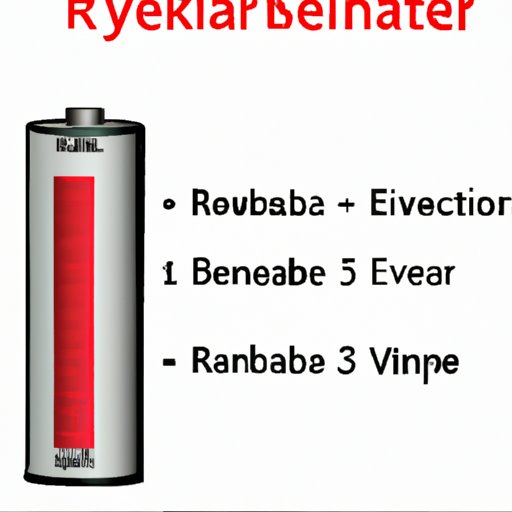Introduction
A battery is a device that stores energy and converts it into electrical energy. It consists of one or more cells, each of which contains chemical substances such as lead acid, nickel cadmium, nickel metal hydride, or lithium ion. The purpose of this article is to explore how a battery works by looking at the chemical and physical processes involved.

Exploring the Chemistry of Batteries and How They Work
The process of creating electricity in a battery involves a series of chemical reactions. A chemical reaction occurs when two or more molecules interact and form new compounds. Inside a battery, these reactions take place between the anode, cathode, and electrolyte.
The anode is the negative terminal of the battery, where electrons enter the cell. The cathode is the positive terminal, where electrons leave the cell. The electrolyte is a liquid or gel that conducts the electrical current between the anode and cathode.
These reactions are known as redox reactions, which involve the transfer of electrons from one compound to another. During a redox reaction, oxidation and reduction occur simultaneously. Oxidation is the loss of electrons by a molecule, while reduction is the gain of electrons by the same molecule.
The chemical reactions occurring inside a battery create an electrical charge. This charge is then stored within the battery until it is released through the terminals. When the battery is connected to an external circuit, the electrons flow freely, creating an electric current.

Examining the Components of a Battery and How They Function Together
Batteries consist of several components, including an anode, cathode, electrolyte, separator, and container. The anode and cathode are made up of metal plates covered in active material, such as zinc or carbon. The electrolyte is a liquid or gel that allows ions to move between the anode and cathode. The separator is a thin membrane that prevents the anode and cathode from touching and short-circuiting.
The container holds all of the components together and keeps them sealed from the outside environment. It also contains the positive and negative terminals, which provide a connection to the external circuit.
When the battery is connected to an external circuit, the anode releases electrons, which travel through the electrolyte to the cathode. At the same time, ions in the electrolyte travel from the cathode to the anode. This creates an electrical current, which can then be used to power a device.
Investigating the Physics Behind Battery Power
In order to understand how a battery works, it is important to have a basic understanding of the physics behind electricity. Voltage, current, resistance, and power are all terms used to describe the behavior of electricity.
Voltage is a measure of the potential energy between two points in a circuit. Current is a measure of the rate at which electricity flows through a circuit. Resistance is a measure of the opposition to the flow of electricity. And power is a measure of the rate at which energy is transferred in a circuit.
The internal resistance of a battery is an important factor in its performance. As the battery is discharged, the internal resistance increases, reducing the amount of current that can be drawn from it. This means that the battery must be recharged regularly in order to maintain its performance.
A Step-by-Step Guide to Understanding Battery Operation
In order to understand how a battery operates, it is important to consider the following steps:
How a Battery Stores Energy
When a battery is charged, chemical reactions occur inside the cells. These reactions create an electrical charge, which is then stored inside the battery. The amount of energy stored in a battery is measured in watt-hours (Wh).
Charging a Battery
In order to recharge a battery, an external source of electricity is required. This could be a solar panel, wind turbine, or mains outlet. When the battery is connected to the external source, chemical reactions occur inside the cells, restoring the electrical charge.
Discharging a Battery
When a battery is connected to an external circuit, the electrical charge stored inside the cells is released. This creates an electric current, which can then be used to power a device. As the battery is discharged, the chemical reactions inside the cells reverse, reducing the amount of energy stored in the battery.

Understanding the Different Types of Batteries and Their Functions
Batteries come in many different shapes and sizes, and they have different functions. Primary batteries are designed to be used once and then discarded. Secondary batteries can be recharged multiple times, but they tend to have a shorter lifespan than primary batteries. Lithium-ion batteries are the most common type of secondary battery and are used in a wide range of applications.
Conclusion
In conclusion, batteries are devices that store energy and convert it into electrical energy. The process of creating electricity in a battery involves a series of chemical reactions between the anode, cathode, and electrolyte. The electrical charge is then stored in the battery until it is released through the terminals. The physics behind battery power includes voltage, current, resistance, and power. Finally, there are several different types of batteries, each with their own unique functions.
By understanding how a battery works, it is possible to maintain battery performance and extend its lifespan. Regular charging and discharging of the battery will help to keep it running efficiently. Additionally, choosing the right type of battery for the application is important in order to ensure optimal performance.
(Note: Is this article not meeting your expectations? Do you have knowledge or insights to share? Unlock new opportunities and expand your reach by joining our authors team. Click Registration to join us and share your expertise with our readers.)
